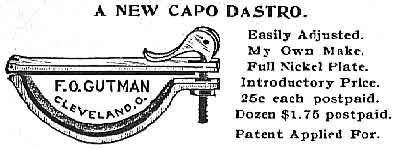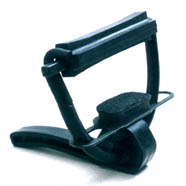![]() Capo with yoke and lever
Capo with yoke and lever
The Very First Patented Capo in the World! This is a real gem in my collection. It is the very first capo that was patended 1850
in the US. It has a ebony bar - very much like the cejilla - with a leather pad. A springy
yoke (looks like brass) is fastened with a screw on top of the bar and is fastened with a
brass screw to a wooden reel under the neck. What looks like a nut is the folded end of
the yoke with a threaded hole. The reel is dressed with thin leather and has a flat
surface. The capo is permanently attached to the neck by removing the reel. By turning the
flat surface away from the neck the spring force from the yoke will hold the capo. To open
it, turn the flat surface up towards the neck. |
|
 |
Capo ad from the 1890's. |
Gutman |
|
 |
Pickerīs Pal The turnable pressure bar has four different shapes to suite fretboards with various radii. The capo is tightened with an eccentric lever on the back of the instrument neck. US patent in 1977 by Elliot L Myerson & Richard W Gillis. |